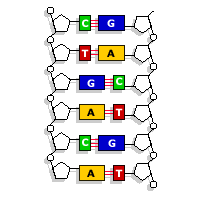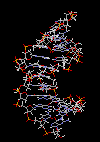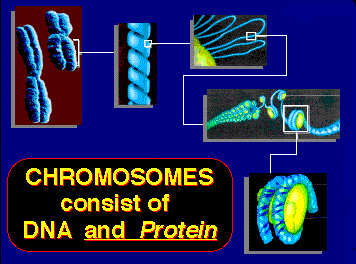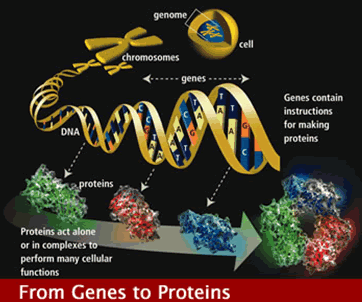![]() Concepts and arguments concerning genes as functional material objects.
Concepts and arguments concerning genes as functional material objects.
Chromosomes must be understood from these two ways: simply as coded blueprints or functionally as contingently active guidance systems.
Gene | Types of | Concepts | Arguments | Chromosomes | Base pair sequences | Proteins | Dialectical approach | Associated genes
Comprehending the terminology of the bio-microcosm, or the very small living world, means that genes, found along discrete sections of chromosomes. Are these stretches of chromosomes we call genes merely signals, or are they more than mere codes for protein manufacture by specific organelles, found deep inside of their protective cells, like the animal (EUKARYOTIC) cell pictured below.
Comprehending the terminology of the biological-microcosm or the world of the very small cells, molecules, and compounds is challenging.
Words that describe the unseen, micro-world; these are the basic terms.
allele - one of numerous forms of a "gene," i.e. protein sequences in hemoglobin.
base pair - In DNA, a sequence of nitrogen compounds: A, T, G, C or U (RNA).
chromosome - elongated body of coherent nitrogen bases, helix shaped and coiled, found in the cell in more than one place: called chromosomes or "dark staining bodies."
plasmid - small loops of encoding DNA residing in bacteria that replicate.
generative - to give rise, to replicate or repair, reproductive ability.
gene - the medium of inheritance: generally a trait, specifically a basic unit of heredity; some information (signal) capable of being inherited.
pangene - the original name given to cellular inheritance
gene pool - all the genes belonging to all the organisms in a population
gene frequency - For any population the rarity or commonness of one form of inheritable sequences (allele) rather than other forms on the same chromosome.
genetic drift - Changes over time in the genetic composition of populations due strictly to chance or statistical variation; often greater in small populations.
genome - the entire component of any organism’s genetic material.
• genotype - the molecularly encoded material make-up of Chromosomes.
• phenotype - the observed expression of the underlying DNA sequences.
genotype refers to what actually is hidden in the base pair sequences - codons
phenotype refers to what is seen, sensed, encountered, smelled, or heard, the expression of the code in the form of proteins.
Gene | Types of | Concepts | Arguments | Chromosomes | Base pair sequences | Proteins | Dialectical approach | Associated genes
antibiotic resistance - survival capacity of bacteria to withstand assault. "The microbes that have survived this selection [of antibiotics] pressure are now demonstrating a disturbing new pattern of resistance–and sometimes complete immunity even to last-resort medicines. Bacteria share genes freely, widening the global threat." "Reflections from Science," Scientific American, April 2011, p. 6.
speciation - a process where geographical or other (behavioral) barriers arise
to separate organisms into two different and distinct breeding populations. This separation of gene pools (the aggregate genes in a population) is more restricted in animals than in plants or bacteria.
nature (genetics) versus nurture (environment) as reasons for behavior.
bequest (inheritance) versus behavior (up-brining)adaptation as fitness; adjusting to ecological change is confused with the capacity to leave offspring that survive into an adult or reproductive stage.
Dialectical
materialism - belief
that existence is binary and best understood as a unity of
opposite tendencies. In the struggle of opposites a driving force propels everything
on.
technological determinism - a set ideals or an ideology which expresses a belief that existence is largely governed by how tools and technical systems force people to react
The derived words from basic genetic ideas:
regenerative - to again give rise, to replicate, replace, or repair another time, reproductive ability is that creatures are capable of having offspring.
The regenerative ability of all life, that is the capability of an organism
to exploit available niches, has been studied from both a structural and a functional
perspective.
Structural refers to how the component parts come together to form a larger whole. Whereas the functional view looks at how the process of bringing different parts together enables ingredients to become assembled into some opportunity, product or outcome.
Gene | Types of | Concepts | Arguments | Chromosomes | Base pair sequences | Proteins | Dialectical approach | Associated genes
Chromosomes must be understood
from these two ways:
1). structurally and 2). functionally.
1). Structural approach:
This means that you describe a way something appears, is shaped, or is constructed.
DNA or deoxyribonucleic acid is the material passed on from one generation to another by means of either mitotic (simple) division, or meiotic (reduction) division of cells or parts of cells [such as: the chloroplast and mitochondria).


Codon - section of base pairs that–in sets of three–determine amino
acids.
introns - sections of the base pairs that intrude, with no apparent sequence into the codon and do not instruct the formation of amino acids
exons - those stretches of the codon that instruct the RNA to form one in particular of the twenty amino acids
transposons - those exons sections of the codons that appear to move from one chromosome to another, for reasons, as yet, not well understood.
Gene | Types of | Concepts | Arguments | Chromosomes | Base pair sequences | Proteins | Dialectical approach | Associated genes
junk DNA - significant amounts of DNA that do not contribute instructions for making any of the sixty to eighty thousand genes, for instance, that humans possess.

chromosomes contain the DNA material that RNA edits in order to build amino
acid sequences in the ribosomes into proteins

ribosomes
amino acids - 20 varieties of macromolecule whose sequence determine  the kind
of protein created in the ribosomes by RNA in cells, or in organelles. For
example: UUU (three uracil bases) codes for phenylalanine and amino acid.
the kind
of protein created in the ribosomes by RNA in cells, or in organelles. For
example: UUU (three uracil bases) codes for phenylalanine and amino acid.
 proteins -are builders, nourishments, and decomposers of life in that they form
enzymes that change, and hormones that regulate, and lipoprotein structures
that maintain metabolic, homeostasis and reproductive activities in all living
things.
proteins -are builders, nourishments, and decomposers of life in that they form
enzymes that change, and hormones that regulate, and lipoprotein structures
that maintain metabolic, homeostasis and reproductive activities in all living
things.
protein folding - refers to the means by which the amino acids as an inert sequence of amino acids
(which form the protein and whose sequences are dictated by the DNA- base pairs--)
are designed into a functional unit that can perform tasks.
2). Functional approach:
This means that you judge something and then describe it by how it works or what it does.
“The fundamental evolutionary event is a change in the frequency of genes
and chromosome configurations in a population.” (over time) “Hence over
several generations.”
Edward O. Wilson, The Diversity of Life, p. 75.
point vs. counterpoint
“The human body contains approximately one trillion cells (one million
squared).... Inside the cell there is...the nucleus .....Inside the nucleus are
two complete sets of the human genome....,each set includes the same 60,000
to 80,000 genes on the same twenty-three chromosomes.”
“The idea of the genome as a book is not, strictly speaking, even a metaphor. It is literally true. A book is a piece of digital information, written in linear, one dimensional and one-directional form,...So is the genome.”
Matt Ridley, pp. 6-7.
Counterpoint:
"This is the metaphor of the empty bucket. Genes determine the size of the bucket and the environment determines how much is poured into it. If the environment is poor, then none of the buckets will have much in it at all and all genotypes will do poorly."“The organism is determined neither by its genes nor by its environment nor even by the interaction between them, but bears a significant mark of random processes."
Richard Lewontin, The Triple Helix. p. 38.
Gene | Types of | Concepts | Arguments | Chromosomes | Base pair sequences | Proteins | Dialectical approach | Associated genes
“There is a family of genes called apolipoprotein genes, or APO genes. They come in four basic varieties…though there are various different versions on of each on different chromosomes.”
One of these is found on chromosome 19.
“The job of APOEs protein is to…effect an introduction between VLDL and a receptor on a cell that needs some triglycerides.”Matt Ridley, p. 259.
For the role ofthe APOE gene on Chromosome 19 in Alzheimer's disease, see here.
Gene | Types of | Concepts | Arguments | Chromosomes | Base pair sequences | Proteins | Dialectical approach | Associated genes